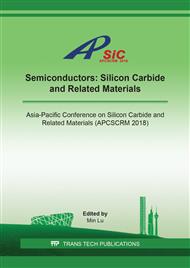[1]
T. Kimoto, Material science and device physics in SiC technology for high-voltage power devices, J. J. Appl. Phys. 54 (2015) 040103.
DOI: 10.7567/jjap.54.040103
Google Scholar
[2]
H. Fujiwara, H. Naruoka, M. Konishi, K. Hamada, T. Katsuno, T. Ishikawa, Y. Watanabe and T. Endo, Impact of surface morphology above threading dislocations on leakage current in 4H-SiC diodes, Appl. Phys. Lett. 101 (2012) 042104.
DOI: 10.1063/1.4738886
Google Scholar
[3]
M. Skowronski and S. Ha, Degradation of hexagonal silicon-carbide-based bipolar devices, J. Appl. Phys. 99 (2006) 011101.
DOI: 10.1063/1.2159578
Google Scholar
[4]
A. Agarwal, H. Fatima, S. Haney and S. Ryu, A new degradation mechanism in high-voltage SiC power MOSFETs, IEEE Electron Device Lett. 28 (2007) 587-589.
DOI: 10.1109/led.2007.897861
Google Scholar
[5]
Q. Zhang, A. Agarwal, A. Burk, M. O'Loughlin, J. Palmour, R. Stahlbush and C. Scozzie, Influence of Shockley stacking fault generation on electrical behavior of 4H-SiC 10 kV MPS diodes, Mater. Sci. Forum 645-648 (2010) 331-334.
DOI: 10.4028/www.scientific.net/msf.645-648.331
Google Scholar
[6]
H. Tsuchida, I. Kamata, T. Miyazawa, M. Ito, X. Zhang and M. Nagano, Recent advances in 4H-SiC epitaxy for high-voltage power devices, Mater. Sci. Semicond. Process. 78 (2018) 2-12.
DOI: 10.1016/j.mssp.2017.11.003
Google Scholar
[7]
X. Zhang, M. Skowronski, K.X. Liu, R.E. Stahlbush, J.J. Sumakeris, M.J. Paisley and M.J. O'Loughlin, Glide and multiplication of basal plane dislocations during 4H-SiC Homoepitaxy, J. Appl. Phys. 102 (2007) 093520.
DOI: 10.1063/1.2809343
Google Scholar
[8]
M. Nagano, H. Tsuchida, T. Suzuki, T. Hatakeyama, J. Senzaki and K. Fukuda, Annealing induced extended defects in as-grown and ion-implanted 4H-SiC epitaxial layers, J. Appl. Phys. 108 (2010) 013511.
DOI: 10.1063/1.3457840
Google Scholar
[9]
X. Zhang, M. Nagano and H. Tsuchida, Correlation between thermal stress and formation of interfacial dislocations during 4H-SiC epitaxy and thermal annealing, Mater. Sci. Forum 679-680 (2010) 306-309.
DOI: 10.4028/www.scientific.net/msf.679-680.306
Google Scholar
[10]
X. Zhang, T. Miyazawa and H. Tsuchida, Critical conditions of misfit dislocation formation in 4H-SiC epilayers, Mater. Sci. Forum 717-720 (2012) 313-318.
DOI: 10.4028/www.scientific.net/msf.717-720.313
Google Scholar
[11]
S. Ha, H.J. Chung, N.T. Nuhfer and M. Skowronski, Dislocation nucleation in 4H silicon carbide epitaxy, J. Cryst. Growth 262 (2004) 130-138.
DOI: 10.1016/j.jcrysgro.2003.09.054
Google Scholar
[12]
S. Ha, M. Skowronski and H. Lendenmann, Nucleation sites of recombination-enhanced stacking fault in silicon carbide p-i-n diodes, J. Appl. Phys. 96 (2004) 393-398.
DOI: 10.1063/1.1756218
Google Scholar


